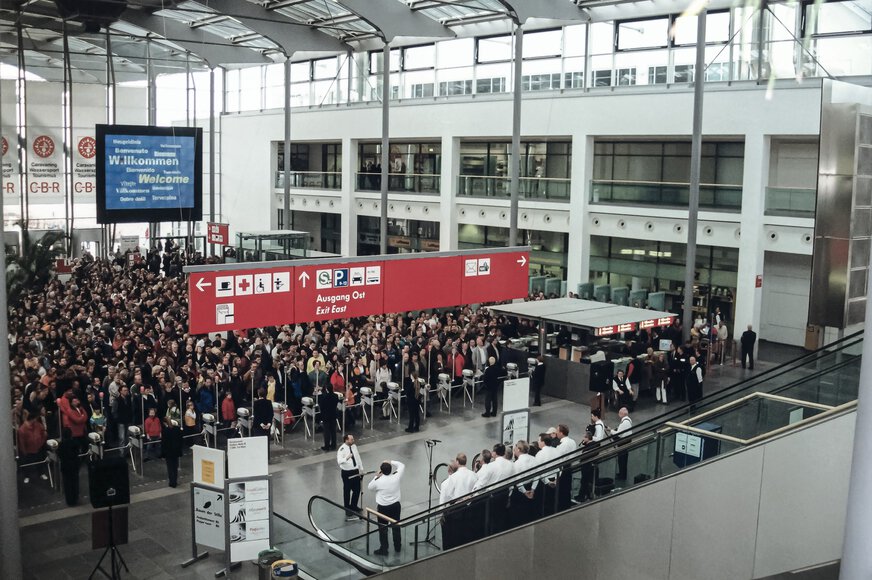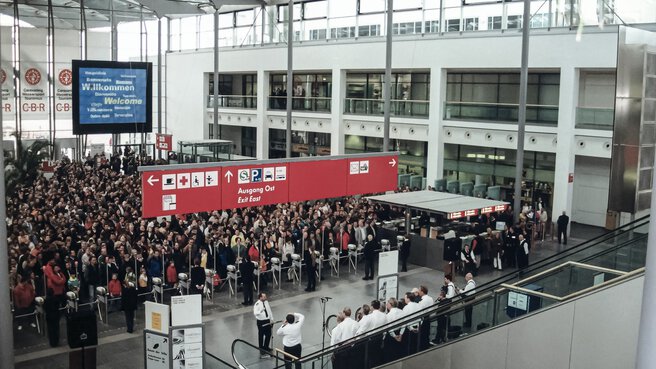25-year trade fair site München-Riem—a new era dawns
With the move to the erstwhile airport, on February 12, 1998, Messe München set the course for its expansion into one of the world’s leading trade fair organizers.
We will be celebrating Messe München’s 25th anniversary at the Riem site as the resounding success of a courageous decision made back in the day. The exhibition center’s move in 1998 produced a once-in-a-century opportunity—with new exhibition grounds, turning the rapidly growing Messe München into one of the world’s most modern, most attractive and biggest trade fair companies. Only at this bigger site was it possible to expand leading international trade fairs such as electronica, for example, and to establish bauma, the world’s largest trade fair in terms of area, with its current, one-of-a-kind magnitude.
It was a great day in Messe München’s history. After 34 years at the Theresienhöhe site, on February 12, 1998, the new Messe München relocated to the site of the former Riem airport. Within just three and a half years of construction the impressive landscape of halls was ready by the mid-1990s. Initially Messe München had 13 halls on 140,000 m² of exhibition space. The construction was also crucial for the Bavarian capital city—it was the second really large-scale project since the 1972 Olympic Games. As a, “trade fair of short distances” with top quality and filigree architecture, planned by architecture firm Prof. Kaup, Dr. Scholz und Partner together with engineering firm Obermeyer Planen und Beraten, the Munich exhibition center became one of the most modern in Germany. The company has grown continuously and sustainably with the relocation. Munich is today one of the most successful exhibition locations in the world.

The new exhibition grounds are today an established component of the vibrant and functional Messestadt Riem district. Of course it was all very different in the mid-1990s. The entire site was like a barren asphalt desert with the former airport’s runways. The construction of the new exhibition grounds made a decisive contribution to the city’s development. Furthermore it also ensured connection to the subway network—an indispensable factor for today’s Messestadt Riem district and its infrastructure.
Progress, sustainability, environmental friendliness with the site construction
Future viability played a key role, and not just with the new district’s development—when building the modern exhibition grounds the focus was also on forward-thinking architecture and environmental compatibility. 220,000 m² of the entire site are therefore a dedicated green space with 2,500 planted trees. A total of 71,000 m² of the hall roofs are planted with greenery. Messe München was therefore already making a major contribution to environmental friendliness, air pollution control and green spaces in the Munich area 25 years ago. The photovoltaic system on the roofs of the trade fair halls (which was one of the biggest of its kind in Europe when installed), also shows how Messe München has always been concerned with careful and sparing use of resources.
The new exhibition grounds were constructed in record time 25 years ago—just three and a half years from breaking ground to opening day. The large-scale project also scored well in financial terms. The planned costs for the first construction phase (six A halls, six B halls, a 3/4 hall (C3), ICM, trade fair building, west and east entrances, as well as east and north service operations) were estimated at DM 2.3 billion, which, however, came in at DM 400 million less, so that among other elements, two further halls (C1 and C2) and the car park were then also built immediately after. The exhibition grounds were completed precisely twenty years later in 2018 with the official opening of halls C5 and C6 and the Conference Center Nord.
Grandiose start into Munich’s new trade fair era
All these successes were celebrated with the inaugural ceremony in 1998. A prestigious ceremony was held in Hall B1 on February 12, 1998, with some 5,000 guests invited from political, economic and social life. Among the guests were the Federal President of the day, Roman Herzog, the head of the Bavarian Government, Edmund Stoiber and Munich’s Lord Mayor, Christian Ude. The grand opening of the new exhibition grounds under the auspices of Messe München’s Managing Director at the time, Manfred Wutzlhofer, was also a particularly special event for the people of Munich. Trade fair operations began just two days after the opening: Caravan-Boot-Reisen (C-B-R), predecessor of today’s f.re.e, Bavaria’s biggest travel and leisure trade fair, was the first trade fair to open its turnstiles on the new site.

Messe history
You will find information on Messe München’s history in our “Messe history”.
Back then: The new Messe München exhibition grounds in photos










Today: Current Messe München photos








